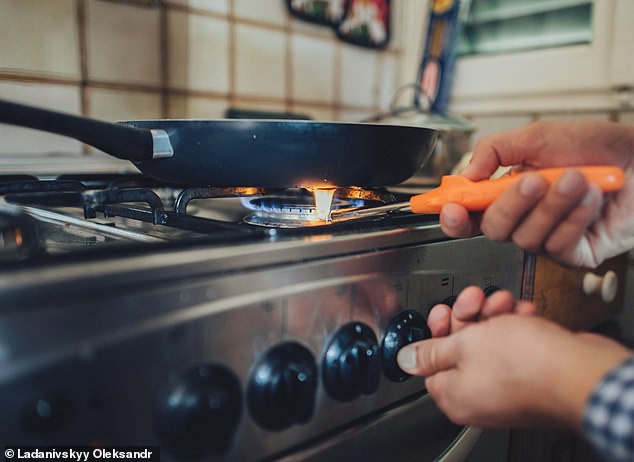If you’re still using a gas stove in your kitchen, a new study suggests you should make the switch to a trendy alternative.
Cooking with a gas-burning stove creates more toxic air than on the famously traffic-heavy Marylebone Road in central London, say experts at Which?
Gas stoves release two harmful pollutants called nitrogen dioxide (NO2) and PM2.5 – fine particles with a diameter 2.5 micrometers or less.
NO2 can lead to health issues like inflamed airways while aggravating existing heart and lung diseases, while PM2.5 can enter the lungs and then the bloodstream, lodging in the heart, brain and other organs.
‘It’s shocking to think that something as routine as cooking dinner could be releasing harmful pollutants into our own homes,’ said Emily Seymour, energy and sustainability editor at Which?
‘But our snapshot research shows that once it spikes, air pollution can spread rapidly through the house and linger for long periods of time.’
Instead of a gas stove, the experts say people should use a trendy induction hob, which has heated copper coils beneath a flat glass surface.
Induction cooktops safer than gas because they don’t emit as much pollutants or involve flames – but overhauling your kitchen with one can cost hundreds of pounds.

New research by Which? suggests cooking on a gas hob can create more air pollution indoors than levels found on one of the UK’s busiest roads

Instead, the experts suggest you should use an induction hob (pictured) which has heated copper coils beneath a flat glass surface
For their investigation, conducted back in November, Which? gave air quality monitors to five volunteers – four with gas hobs and one with an induction hob.
Levels of NO2 and PM2.5 were both measured as micrograms (one-millionth of a gram) per cubic meter of air (µg/m3).
In the kitchen, NO2 specifically comes from the combustion natural gas flowing from a gas cooker, while the PM2.5 is an emission from food as it cooks in the pan.
Volunteers were required to carry out a variety of cooking scenarios while using extractor hoods, in addition to their normal usage over the course of a week.
They were asked to keep windows and doors shut, aside from one test scenario where they fully ventilated the kitchen.
Meanwhile, researchers sampled air pollution on London’s Marylebone Road during the same period in November.
They recorded 33µg/m3 for NO2 and 14µg/m3 for PM2.5, on average, both of which mainly come from traffic.
In comparison, nearly all volunteers using a gas hob experienced PM2.5 peaks of more than 100µg/m3 on several occasions.

Which? gave air quality monitors to five volunteers – four with gas hobs and one with an induction hob. This graph shows PM2.5 emissions during one of the scenarios (cooking for 10 minutes with multiple rings on the hob)

This graph shows NO2 emissions while slow cooking (using just one ring on the hob). (Note that the NO2 levels experienced by the single volunteer who used the induction hob were mainly from outdoor pollution)
One volunteer experienced a peak PM2.5 of nearly 650µg/m3 when frying Padron peppers, while another experienced nearly 600µg/m3 when frying peppers and tomatoes and two had peaks of nearly 500µg/m3 when cooking a fry-up.
All of these greatly exceed the 24-hour mean guidance limit from the World Health Organization (WHO) for PM2.5 (15µg/m3).
Meanwhile, NO2 rose with the use of a gas hob – in one case pushing past 60µg/m3 while slow cooking with just one ring while using a fan.
Unsurprisingly, the more people used the gas hob and the more gas rings that they used, the more NO2 emissions there were in the surrounding air.
Once levels of NO2 had spiked, Which? found that they remained elevated for significant periods of time – often several hours.
When volunteers moved the air monitors into an adjoining room (or the living area if their house was open plan), air pollution was shown to have spread through the home rapidly.
Which? also found that opening windows during frying reduced PM2.5 levels compared with keeping windows closed.
This suggests that keeping your home ventilated is a key defence against air pollution – although this may not be a realistic option during the winter.

Particulate matter, or PM, comes from a variety of sources, including vehicle exhausts, construction sites, industrial activity or even domestic stoves and ovens. PM2.5 is particulate pollutant 2.5 micrometres or smaller in size
In another scenario, Which? asked all volunteers to fry food in oil for 10 minutes, but with all windows and any external doors open during frying and for 10 minutes afterwards.
In this case, PM2.5 levels rose by far less than in all the other frying scenarios
The average peak reached by the five participants was 27µg/m3, whereas the next lowest average for any of the frying scenarios Which? carried out was 100µg/m3.
In addition to the findings, Which?’s surveys suggest awareness of indoor air pollution is low.
In a survey of 2,002 UK adults about air pollution, only 25 per cent of those with gas hobs and 18 per cent with electric hobs said they were concerned about the possible impact on their health.
Which? also points out that there are still significant knowledge gaps around the impact of air pollution on the human body.
Humans constantly move between ‘cocktails of chemicals’ from different sources – such as diesel engines, woodsmoke, cooking and cleaning products.
‘We still don’t know the full impact of indoor pollutants on our health but if it is something you are concerned about, ventilating by using your extractor hood and opening windows can make a big difference,’ said Seymour.
‘If you are using a gas hob you could consider switching to induction when you next need to replace your hob.’
This article was originally published by a www.dailymail.co.uk . Read the Original article here. .


